
These include Basic Circuits and Logic Circuits. If these are understood properly, then it should be possible to design mole complicated circuits. As it is not intended to deal with all the circuits in this booklet, only a few of the basic circuits are dealt with here
This consists of a cylinder-either a single-acting or a double acting, and a control valve. This is shown in the Fig. 3, below:

The valve can be operated manually (by a lever), by pilot air or by solenoid. When the valve is actuated, the valve changes position and air is supplied to the blind end of the cylinder, which moves the piston forward. The piston will move forward (and remain in the extended position) as long as the valve is under actuation. The moment the actuation force OD the valve is withdrawn, air supply to the blind end of the cylinder is switched to the rod end of the cylinder. The piston will then perform its return stroke and remain in the original position until the valve is actuated again.
2, The figure given below shows a circuit where the cylinder is actuated by a mere pulse signal and the piston will perform a forward and a return stroke without waiting for any subsequent signal from the operator.

FIG.4
When the manually operated valve (B) is actuated, air is supplied through valve B, through the already actuated valve (C) to the main control valve (A). This actuates the main control valve (A) and shifts its position. Air will now be supplied through the main control valve (A) to the blind-end of the cylinder, and moves the piston forward. When the piston moves forward, it releases the mechanically operated valve C and the air supply through this valve is blocked. When the actuating force on the manually operated valve (B) is released, then it returns to its original position and the air supply through it would be blocked. However, the piston will continue to move forward. At the end of its forward stroke, the piston will actuate the valve (D), when the air will be supplied through this valve to the main control valve (A). At (A) this will un-actuate the main control valve, and it will return to its original position. This will shift the air supply to the rod end of the cylinder and the piston will perform its return stroke and stay in the retracted position till again the main control valve is actuated.
Fig. 5 shows a Logic Circuit which performs the' AND function.

FIG. 5
It can be seen from the above circuit diagram that only when valves (L) and (R) are actuated, the main 'control valve is actuated and the piston starts the forward stroke. If either (L) or (R) are not actuated, then the piston will not move forward.
This circuit can be used to provide safety to the operators of machines such as, presses.
Unless the operator's both hands are used for actuating the valves (L) and (R), and hence away from the work table. the press cannot be operated. This prevents any harm to the operator's hands, which otherwise would be there, due to negligence etc,